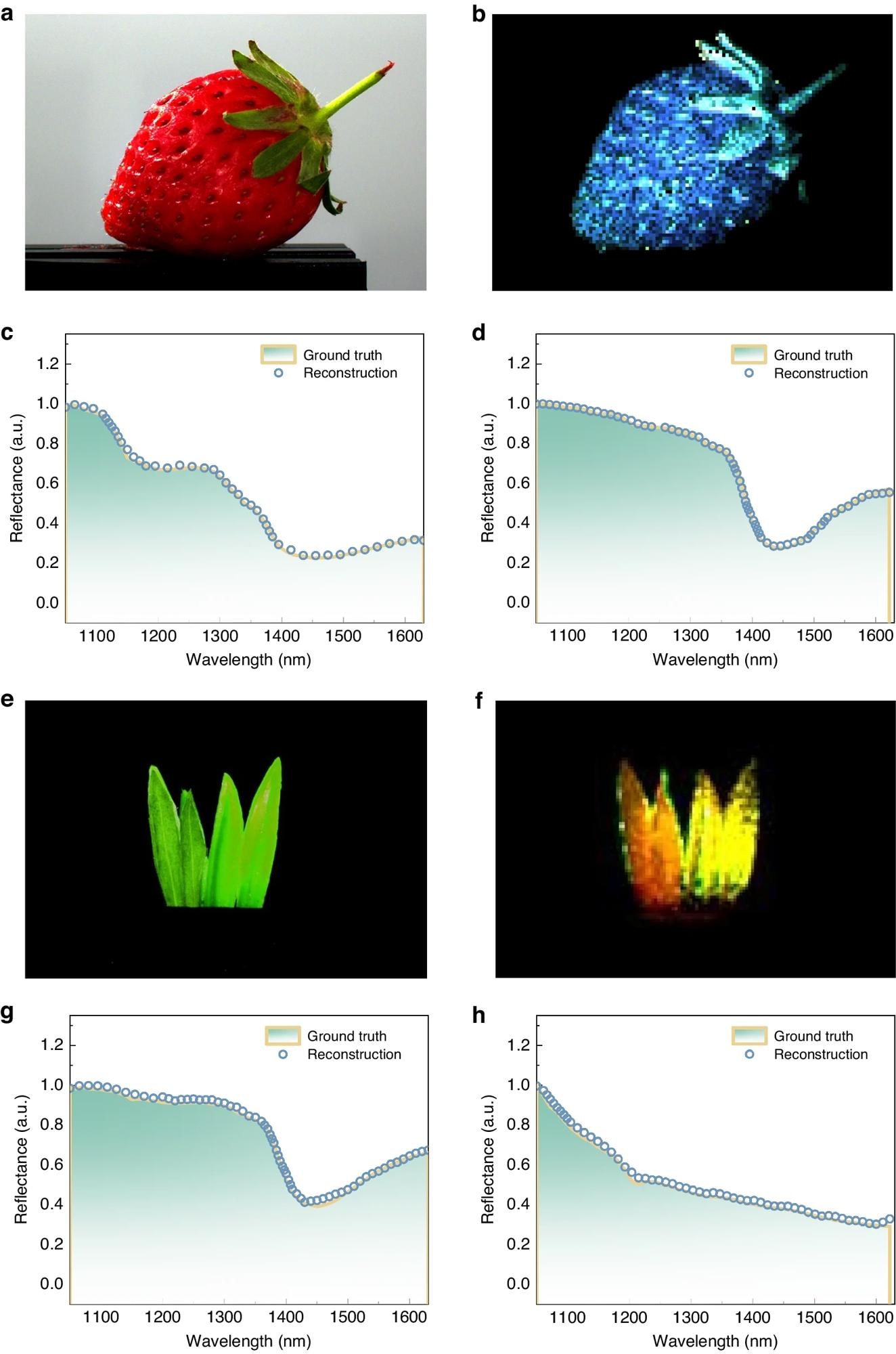In a recent article published in Light: Science & Applications, researchers investigated the feasibility of using single-pixel detection in conjunction with colloidal quantum dots (CQD) filters for near-infrared (NIR) hyperspectral imaging.

a) Color photo and b) hyperspectral image of a fresh strawberry. The reconstructed reflection spectra of the c) receptacle (flesh) and d) sepal (leaf) of the strawberry. e) Color photo and f) hyperspectral image of a mixture of real and plastic grasses. The reconstructed reflection spectra of the g) real grasses and h) plastic grasses. Image Credit: https://www.nature.com/articles/s41377-024-01476-4
a) Color photo and b) hyperspectral image of a fresh strawberry. The reconstructed reflection spectra of the c) receptacle (flesh) and d) sepal (leaf) of the strawberry. e) Color photo and f) hyperspectral image of a mixture of real and plastic grasses. The reconstructed reflection spectra of the g) real grasses and h) plastic grasses. Image Credit: https://www.nature.com/articles/s41377-024-01476-4
NIR Hyperspectral Imaging Challenges
NIR hyperspectral imaging provides comprehensive spectral information across a broad spectrum of NIR wavelengths. This enables spectral signature-based characterization and identification of chemical compounds and materials, which can be utilized for different applications, such as quality control. Although several strategies, such as narrow-band light filters, have been employed to resolve a scene's spectral information, each has its own limitations.
Broad-band light encoding-based computational spectral reconstruction has gained attention with the advancements in computational capabilities and algorithms. CQDs can offer a suitable solution for broad-band filter fabrication as they can continuously tune their absorption characteristics from ultraviolet to mid-infrared by altering their chemical composition and size.
Hyperspectral images are represented as a three-dimensional (3D) data cube comprising the scene's spectral dimension and two spatial dimensions for analysis and processing. As the hyperspectral cube is obtained through spectral or spatial scanning, a two-dimensional (2D) infrared sensor is used for NIR hyperspectral imaging to capture a full slit spectrum or the spatial map of the scene.
However, the fabrication of large-scale indium gallium arsenide (InGaAs) detector arrays with high yield is difficult owing to the complex fabrication process and detector sensitivity to process variations. Additionally, complex integration and packaging processes are required to integrate the 2D InGaAs detector arrays into real-world imaging systems. Moreover, the high cost associated with InGaAs focal plane arrays has hindered the extensive adoption of NIR hyperspectral imaging.
The Study
In this study, researchers proposed using single-pixel detection in conjunction with CQD filters for NIR hyperspectral imaging as an alternative approach to effectively address challenges like complex wavelength selection components and the high cost of 2D NIR sensors and increase the affordability of NIR hyperspectral imagers for daily usages.
Specifically, they implemented this strategy by leveraging a digital micromirror device (DMD) and self-assembled CQDs for NIR spatial and spectral information multiplexing, which was complemented by simultaneous single-pixel detection for image and spectral reconstruction.
The spectral information encoding employed lead sulfide (PbS) CQD filters, which offered a scalable solution with versatile and cost-effective solution-processing capabilities. By altering the size of CQDs, the CQD filters' transmission characteristics were changed to modulate the signal's spectral information.
Researchers encoded the scene's spatial information by changing the pattern of a DMD. Thus, the signals the single-pixel InGaAs detector received were spatially and spectrally modulated by the DMD and the CQD filters.
The synthesized PbS CQDs were initially purified twice using ethanol and then redispersed in hexane before device fabrication. In the CQD filter fabrication process, the glass substrate was initially soaked in isopropyl alcohol and ultrasonic cleaned for 30 min.
After drying, the substrate was cleaned using a plasma cleaner to enhance the CQDs' adhesion effect on the substrate surface. Subsequently, a solution of PbS CQDs was dropped on the substrate center and allowed to spread on the substrate.
A dust shield was used to cover the filter to prevent dust in the air from contaminating the material. Eventually, the solvent was completely volatilized after 24 h to complete the film deposition, and a black film was obtained on the substrate.
Importance of the Work
Successful NIR hyperspectral imaging was demonstrated in the experiment results with a 600 nm detection window and 8.6 nm average spectral resolution with a pixel resolution of 128 × 128, with each pixel providing a complete spectrum.
Using the compressed sensing algorithm, the NIR hyperspectral image with 128 × 128 pixel resolution was obtained, where each pixel contained a spectral signature from 1050 to 1630 nm, by correlating the signals with the 50 self-assembled CQD filters' transmission spectra and the DMD-generated patterns.
The single-pixel detection outperformed the conventional focal plane array, delivering an improved signal-to-noise ratio (SNR) for both imaging and spectral reconstruction. The resulting spatial and spectral data aligned well with reference instruments, which validated the effectiveness of the proposed approach.
Specifically, the reconstructed spectra demonstrated excellent consistency with commercial spectrometers, confirming the approach's reliability and accuracy.
Conclusion
To summarize, the findings of this study showed the feasibility of using single-pixel detection in conjunction with CQD filters for NIR hyperspectral imaging. By circumventing the need for bulky and expensive focal plane arrays and wavelength selection components, the proposed approach can play a critical role in advancing accessible and affordable NIR hyperspectral imaging technologies, thereby expanding the range of potential applications.
Journal Reference
Meng, H., Gao, Y., Wang, X., Li, X., Wang, L., Zhao, X., Sun, B. (2024). Quantum dot-enabled infrared hyperspectral imaging with single-pixel detection. Light: Science & Applications, 13(1), 1-10. https://doi.org/10.1038/s41377-024-01476-4, https://www.nature.com/articles/s41377-024-01476-4
Disclaimer: The views expressed here are those of the author expressed in their private capacity and do not necessarily represent the views of AZoM.com Limited T/A AZoNetwork the owner and operator of this website. This disclaimer forms part of the Terms and conditions of use of this website.